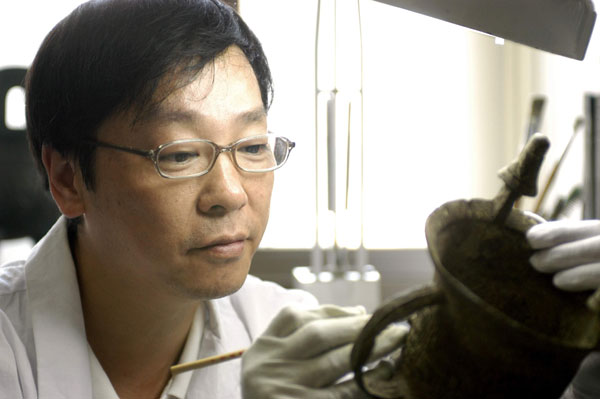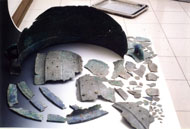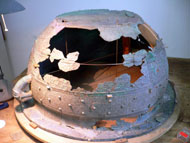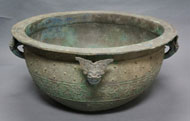Zhang Guangmin has spent the past 16 years on a most difficult — and costly-game of jigsaw puzzle. On Oct 18, the antique restorer finally placed the last piece of the puzzle — a 2,000-year-old giant water bowl — together.
"I was very anxious to complete it this year as our museum is celebrating its 60th anniversary," says Zhang, who has been restoring bronze at Shanghai Museum for 37 years. "Thanks to an ultra-sound knife, I have accomplished the seemingly impossible mission," he adds in relieve.
 |
|
The process of piecing together the 2,000-year-old bronze ware has taken Zhang Guangmin 16 years to complete. Photo Provided to China Daily |
Former museum director Ma Chengyuan (1927-2004), who was also an acclaimed scholar on bronze, purchased the bowl with intertwining dragon patterns from Hong Kong.
"Our former director bought it even though it was seriously damaged from previous restoration attempts. It is a unique piece with a highly academic and historic importance," says Zhou Ya, curator of the bronze department of Shanghai Museum.
Named "jian", the vessel is believed to have originated either from the Spring and Autumn Period (770-476 BC) or the Warring States Period (475-221 BC). Jian was used for storing water, ice and bath water. After the Warring States Period, people stopped producing jian.
This one with meticulous and complex dragon patterns is larger than the other two vessels of the same shape among the museum's bronze collections, and the intertwining dragons make it more unusual. It measures 45 centimeters in height, 79 cm in diameter at its opening, and a base diameter of 39 cm.
Shanghai Museum has one of China's best collections of bronze, thanks to the continuous efforts by generations of museum staff. "We have more than 7,000 pieces, forming systematic lineage. Every piece is a national treasure and of great value," Zhou says.
He reveals that there are no bronze sacrificial vessels in the auction market, because they can't possibly have been inherited, and it is against the law to trade these national treasures that belong to the State. But there has been private tradings of these pieces for decades.
"Some businessmen would restore a piece by the most violent and rough means to gain a huge profit," Zhang says.
He has found altered patterns, chemical erosions, added inscriptions and other restoration efforts that caused irreversible damage to treasured bronze pieces.
"You just have to pass by a piece — you don't even have to go up close — and you can feel the difference between a genuine treasure and an artificially crafted fake," he says. "It's as if the real thing can breathe, and emits a special aura."
The professional restorer makes sure that every work he does on a piece is reversible: The added parts can easily be removed in the future, when more advanced techniques are made available to restore the treasure more perfectly.
The restoration of the jian started with dissembling. All the added materials from the previous restoration efforts were removed. Then, the vessel was separated into innumerable small pieces.
|
 |
 |
 |
| The process of piecing together the 2,000-year-old bronze ware has taken Zhang Guangmin 16 years to complete. Photo Provided to China Daily | ||
He built a hemisphere framework before slowly piecing each piece of bronze together to restore it to its original shape. That part of the process took more than 10 years.
Every time after adding a new piece to the frame, restorers had to wait for a few months before adding on another piece.
"Metals have their own strength and resilience," explains Zhou. "You have to make sure a piece is well settled in place, before patching on the next — that's the only way to make sure every piece fits perfectly. You can't rush things."
Zhang and his colleagues explored various ways of reconstructing the treasure, as there is no existing technology available. Bronze as a material for sacrificial vessels is unique of China.
"We went to many precision machinery fairs, and made use of jewelers' and even dentists' tools. You have to be inventive, and find solutions to your problems.
"You need to cut out the pattern in a perfect angle and join it with the existing part — it's like a jigsaw puzzle, but you have to create all the missing pieces," he says.
Zhang is thankful to the Art Conservation Project of Bank of America Merrill Lynch, an initiative to help conserve important works of art and cultural treasures all over the world. This year the project was in China for the first time.
Zhang got connected to the organization and acquired an ultra-sound knife — which was meant for jewelry designing.
"The knife made my work much easier, and helped me complete the restoration faster than expected," Zhang adds.
When the original pieces are reshaped, Zhang had to fill in the missing gaps with low-temperature welding, "to make sure it can be undone easily, if needed," Zhang says.
Then came the most difficult part: to reproduce the intertwining dragon patterns. The patterns are intricate, purely handmade and more than 2,000 years old, on a surface of no more than 1 millimeter at its thinnest.
"It's not mechanical repetition. With every touch, our human hands will unavoidably leave traces of slight differences," Zhang explains.
Members of the public will be able to admire the finished work next year, after the bronze exhibition hall is refurbished at Shanghai Museum, says Chen Kelun, deputy director of Shanghai Museum.
Contact the writer at zhangkun@chinadaily.com.cn
